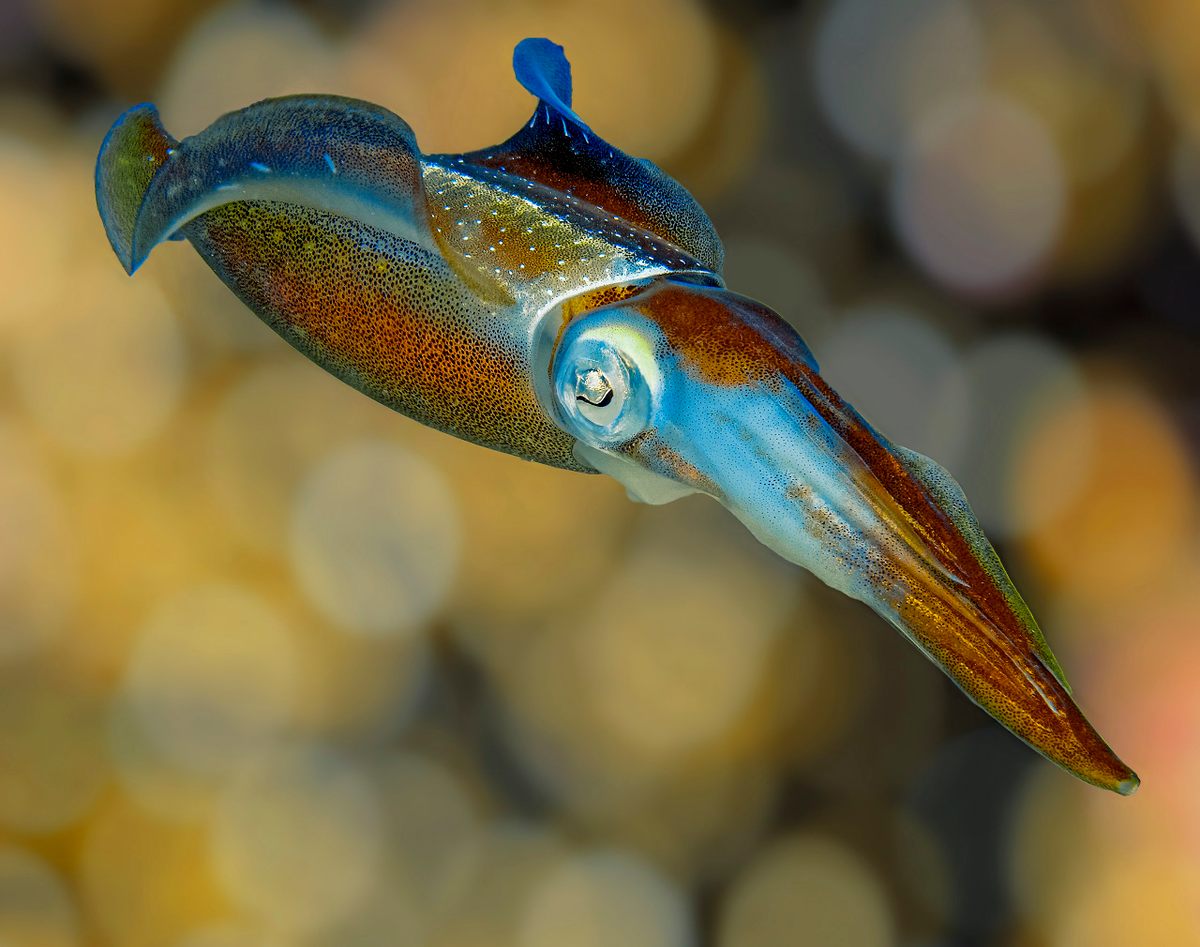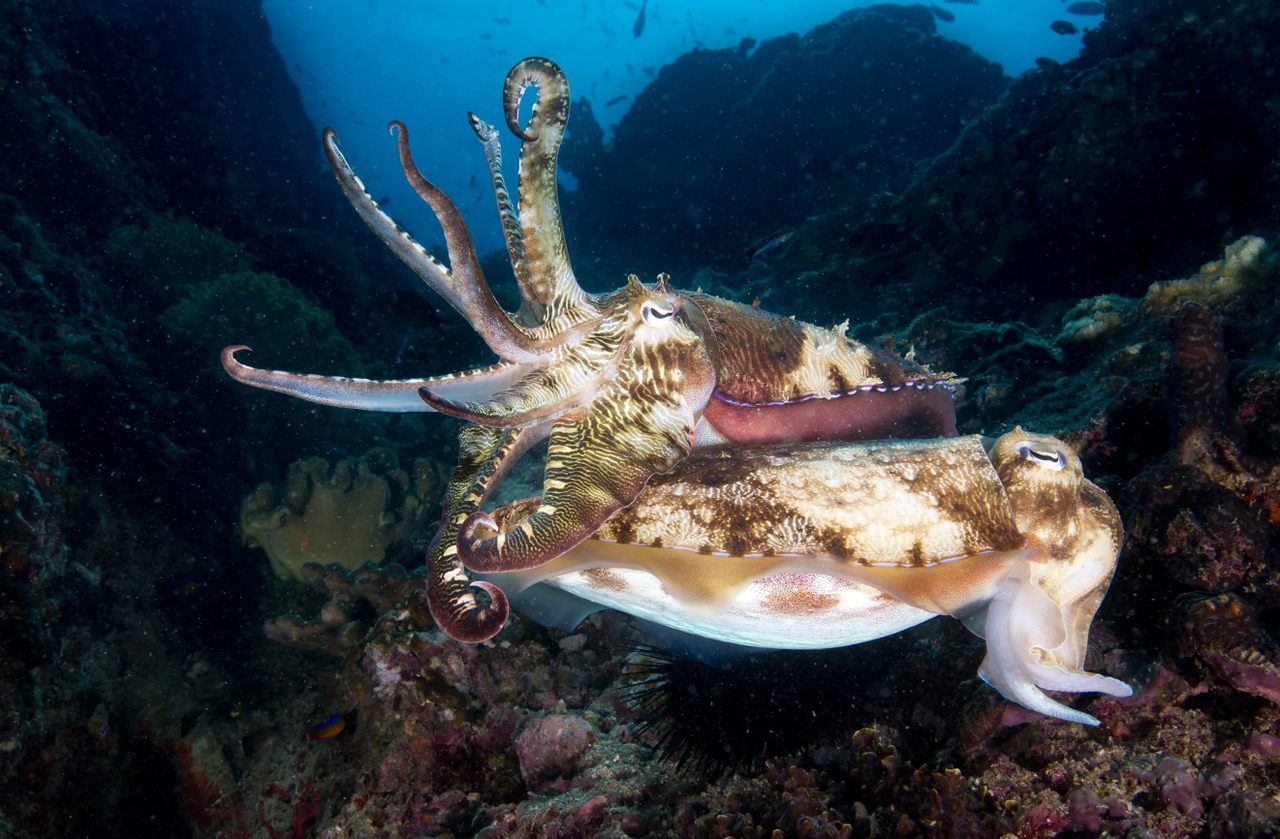The Weird and Wonderful World of Sex Under the Sea
From penis dueling to pee potions to switching sexes, there’s no one right way of getting it on in the ocean.
During the peak of summer off the coast of Maine, a female lobster approaches the den of a potential mate. Male lobsters are aggressive, so she’s whipped up a love potion to win him over. The persuasive concoction is her own pee, full of seductive and disarming pheromones, which springs from a surprising source. “I hate to tell this to people who love to eat lobster,” says Ellen Prager, marine scientist and author of Sex, Drugs, and Sea Slime: The Oceans’ Oddest Creatures and Why They Matter. “Everybody thinks [their bladder] must be under their abdomen, but no, it’s actually between their eyes.”
The female shoots the enticing potion from holes just above her eyes. She’ll return to the male’s den each day, dousing her prospective lover over and over until he comes around to her, letting her into his den without harm. During her two weeks with her new mate, she’ll molt her shell and allow him to fill her new sperm pouch. While males will fall victim to this seduction regularly, females are more selective, saving up sperm to use for years to come, says Prager.
Lobsters are just one sea creature that reminds us land-dwellers how strange sex under the sea can be. From fish making bass-music mating calls that can travel miles inland to an octopus sealing the deal by handing off an arm that’s full of sperm—there’s no one right way of getting it on in the ocean.

The marine environment presents special challenges—and opportunities—for reproduction compared with dry land, says Prager. Animals in the vast open ocean—most of which is lightless—have adapted to find love in myriad ways. For example, some creatures, including many species of corals, are stuck in place, and evolved to let the water handle the actual act of getting busy. For one week each year, hoards of corals release sperm and eggs out into the water in a synchronized mass, hoping they’ll meet and fertilize in the commotion. “When they float up to the surface, it’s like an underwater, upside down snowfall,” says Prager.
Female deep sea anglerfish in the Ceratiidae family, also known as sea devils, prefer to keep their sperm supplies by their side—literally. Males—which are 1/10th the size of females—have large eyes and nostrils with one purpose: seeking out a female in the dark, deep sea. Once they find her, they’ll bestow an everlasting “love bite.” This is no regular smooch: Once the male bites the female, latching onto her, he releases enzymes that dissolve both his flesh and hers, eventually creating a permanent fusion, until death do they part. As their tissues and blood supply merge, the male gets to keep one shred of his dignity—his testes. In the end, as many as six males may be fused to one female, essentially providing an on-demand sperm bank. Talk about clingy.
For some species, it’s not about saving up sperm, but a battle of who gets to share theirs. Hermaphroditic marine flatworms (Pseudobiceros hancockanus) are known to duke it out to determine which one will provide the sperm and which one will receive it. These flamboyant, flowy creatures rear up and attempt to stab each other with their dual-pronged penises. The loser will be saddled with the hassle of rearing the young, while the winner gets to go off to fight another sperm-centric battle.

From hermaphroditic worms to sex-changing fish, the sea is full of gender fluidity. Stoplight parrotfish (Sparisoma viride) are a classic example. When the male of a harem dies, a female will step up in a big way—transitioning into a brightly colored male and taking over the group. And these types of sex-switching strategies aren’t just the purview of parrotfish. “We’re finding that it’s more common than we originally thought,” says Prager. Humphead wrasse can also switch from female to male, while clownfish do the opposite, going from male to female. Species like humphead wrasse and clownfish can only switch sex once, but some species of gobies can change back and forth between the sexes over and over.
For cephalopods—squid, octopuses, and nautiluses—impersonating the opposite sex is just one of their many sneaky strategies. Octopoteuthis deletron is a solitary deep sea squid that takes “a shot in the dark,” slapping a packet of sperm on any member of its species—male or female—that it crosses paths with, says squid biologist and science communicator Sarah McAnulty. Chambered nautilus (Nautilus pompilius) mate face to face in a 24 hour love fest, enveloped in a blob of mucus.
Cephalopods are also known as masters of deception, particularly crafty thanks to their ability to change skin color and shape, says McAnulty—including when it comes to mating. Smaller male Australian giant cuttlefish will pose as females—donning a speckly, splotchy maroon and white pattern and scrunching their two long front arms up to their faces. This camouflage allows them to sneak up to females unnoticed. When bigger males aren’t looking, the pseudo-females will switch back to their male mating coloration—a sheen of blue and purple with zebra stripes—and slip a packet of sperm to a female before jetting off.
“Sperm packets are kind of like the ketchup packets, meaning you can store them for later, or crack it open and use all of the sperm, or just chuck them,” says McAnulty. “When the female goes to lay her eggs, she can pick and choose who she wants to use to fertilize the eggs.” And studies have shown that, when it comes to cephalopod parentage, good things really do come in small packages. Researchers tested clutches of eggs that had been fertilized with sperm from multiple males to learn whether the size of the male was a factor in its mating success. “The little males were getting proportionally more [eggs fertilized] than the bigger males, which is kind of wild,” McAnulty says.

The Caribbean reef squid (Sepioteuthis sepioidea) takes deception one step further, splitting its signaling down the middle of its body. Small males can slip between another male courting a female and show female markings toward the male while dazzling a female with a manly display before handing over the goods and getting out of dodge.
Some male sea creatures skip deceptive tactics and just advertise their availability, bringing the ladies to them. In the darkness, male ostracods—sand-grain-sized crustaceans—send up glowing strings of pearls to attract mates. The beautiful light show is actually bioluminescent strings of vomited saliva. Each beaded cord pattern is unique to a specific ostracod species—of which there are over 300—allowing females to find a suitable mate in the crowd. “If there’s more than one ostracod species in the same place, some of them will do three big dots and then others will do twelve little dots in a row,” says McAnulty. “The little squirts of bioluminescence are how they find each other.” Once they do find a mate, the male emits a stream of sperm which can be up to 10 times the length of his body in some species. “Ostracods are generally underrated weirdos,” says McAnulty.
While knowing sex under the sea can be freaky, there’s something familiar in it, says McAnulty. “Watching animals trying to mate, particularly when they try and fail, is very relatable,” she says with a laugh. “And it’s a reminder that no matter how different we may feel, we’re really just animals. I think that builds empathy for wildlife and animals, and caring for other creatures that we share this planet with.”





























Follow us on Twitter to get the latest on the world's hidden wonders.
Like us on Facebook to get the latest on the world's hidden wonders.
Follow us on Twitter Like us on Facebook